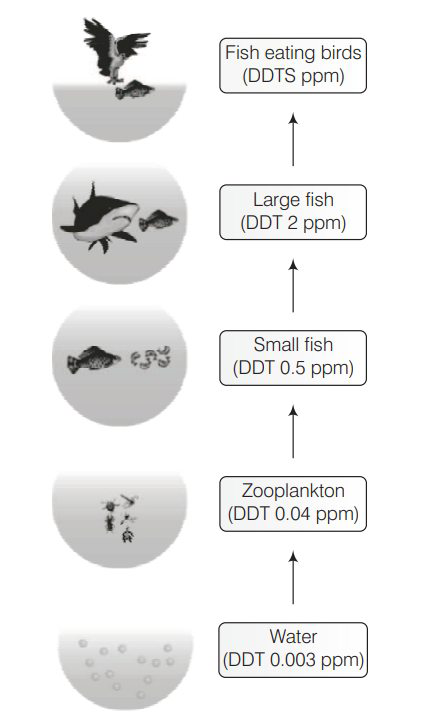Water logging and soil salinity are some of the problems that have come in the wake of the Green Revolution. Discuss their causes and adverse effects to the environment.
Water logging and soil salinity is caused by extensive irrigation without proper drainage of water.
Continuous presence of water draws salt to the surface of the soil, which gets deposited as a thin crust on the land surface or start collecting at the roots of the plants.
Adverse effects
(i) Increased salt content stunts the growth of crop plants.
(ii) Root cells saturated with saline water gets damaged.
(iii) Plants die.
(iv) Crop yield gets affected.
(v) Financial loss to the farmers.
Although properly managing the soil-water system can correct the salination and water logging, but the economic costs of this are very high.
What are multipurpose trees? Give the botanical and local names of any two multipurpose trees known to you and list their uses.
Multipurpose trees are those tree which on plantation fulfills a number of purpose, like shade, providing, soil improvement, provide wood, fruit and food etc. In other words, multipurpose trees serve a wide variety of function and services for human needs.
Neem ( Azardicta, indica) is known for its medicinal properties. Its fruit, leaves, wood and oil extracted from wood is used in most of the ayurvedic medicines. Its wood is pest resistant due to chemical azardiction. Another most important tree is coconut palm.
Its botanical name is Coccos nucifera and belongs to the family-Palmae, it serves a variety of function. As we get oil, wood and food fibre, from this plant. This plant has fibre, medicinal and commercial importance.
Some other multipurpose trees are Moringa oleifera and Gliricidia sepium, which is widely used for fences in central America and provide fire wood fooder and fix atmospheric $\mathrm{N}_2$. While M.oleifera is commonly used for animal forage and shade, its leaves are edible.
What are the basic characteristics of a modern landfill site. List any three and also mention the reasons for their use.
Characteristics of a modern landfill includes
(i) Methods to contain leachate such as lining clay or plastic liners.
(ii) Compaction and covering of the waste to prevent it from being blown by wind.
(iii) Installation of a landfill gas extraction system to extract the gas for use in generation of power.
The use of modern landfill sites must be promoted due to the following reasons
(i) They stimulate the waste prevention via recycling and recovery of waste.
(ii) They create a uniform cost for the disposal of waste which consequntly will prevent the unecessary transport of waste.
(iii) They prevent or reduce the negative eftects on the envirionment, as well as the risks to human health arising from the landfilling of the waste.
How does an electrostatic precipitator work?
Electrostatic precipitator can remove over 99\% particulate matter present in the exhaust from a thermal power plant by the following mechanism
(i) It has electrode wires that are maintained at several thousand volts, which produce a corona that releases electrons.
(ii) These electrons attach to dust particles giving them a net negative charge.
(iii) The collecting plates are grounded and attract the charged dust particles.
(iv) The velocity of air between the plates is kept low enough to allow the dust to fall.
$$ \text { Observe figure and answer the following questions. } $$
 (i) What ecological term is used to describe the DDT accumulation at different trophic levels?
(i) What ecological term is used to describe the DDT accumulation at different trophic levels?
(ii) List any one effect of DDT accumulation on birds.
(iii) Will DDT accumulation lead to eutrophication?
(iv) Does it affect the BOD?
(v) Name disease caused by accumulation of any heavy metal.
(i) The ecological term used to describe the DDT accumulation at different trophic levels is called biomagnification.
(ii) High concentrations of DDT disturb calcium metabolism in birds, which causes thinning of egg shell and their premature breaking, eventually causing decline in bird populations.
(iii) Yes, DDT accumulation can lead to eutrophication.
(iv) It increases the BOD, resulting in a decrease in dissolved oxygen in the water body.
(v) Eating fish that has accumulated mercury, a heavy metal, causes a disease called Minamata. It is characterised by diarrhoea, haemolysis, numbness, deafness, mental derangement, meningitis and death.